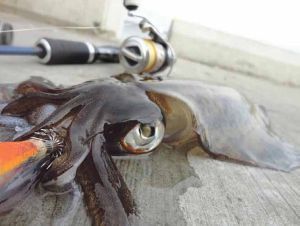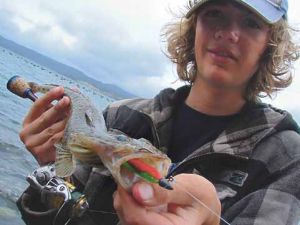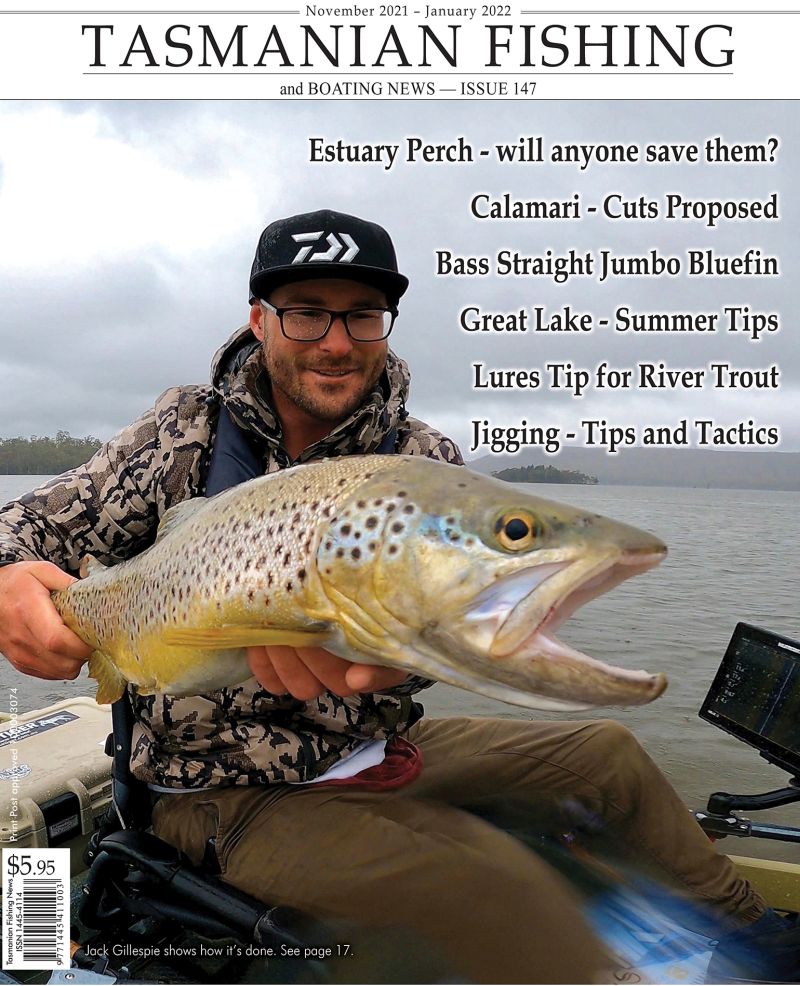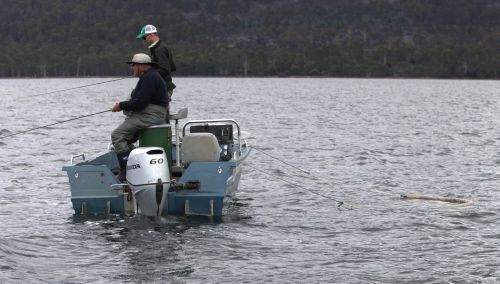 Presented from Issue 109, April 2014
Presented from Issue 109, April 2014
The lower Derwent River and North West Bay can be great places to catch a feed from the shoreline throughout the year. The bays in South Eastern Tasmania boast an impressive head of cockie salmon, sand flathead, squid, wrasse, barracouta well as the odd shark or two, all available to the keen landbased angler. As you move further along the headlands, the species become larger and competent anglers can often take good bags of black-back salmon and nice sized flathead, great fun for the family while catching a feed, all within thirty minutes of home. While this article focus’ on spots thirty minutes from the Kingborough district, the techniques and lures discussed will prove effective all over the state for an array of species.
Techniques
For those looking to catch bigger fish more consistently throughout the year, it’s time to move beyond the fateful paternoster rig and onto more effective and enjoyable methods. While the simple paternoster rig can occasionally yield good results throughout the year from the shore, spinning with a soft plastic or a metal slice is a far more effective means of landing a feed.
Spinning using a variety of lures for bread and butter species doesn’t have to be an expensive affair. However, as with most things in life, you get what you pay for. A simple graphite rod coupled with a solid spinning reel, spooled up with line will set an angler back around $150-200 dollars and will be a joy to fish with throughout the year, not only for the stock standard flathead and salmon. Also for big, beautiful brown trout in the highlands, strong southern black bream in the eastern estuaries as well as the elusive estuary perch in the north west of the state, all from the shore.
Local tackle shops will be able to guide you in your choices of rods, reels and lines based on how often you intend to use the combo. Normally a rod rated around 2-4kg will be more than enough for spinning off rocks, jetties, wharfs and the banks of local rivers. If you fancy a challenge, a lighter 1-3kg rod will be ideal. For getting the fish to the shore fast for the table a slightly ‘beefier’ rod will be more suitable.
As for line, simple monofilament will land almost as many fish as any other line. That said, braided line will lead to more hook ups. ‘Mono’ stretches, meaning that the angler can’t always feel the subtle bites of that wary big fish they’ve been chasing. Braid on the other hand, has almost zero stretch allowing you to always stay ‘in touch’ with your lure or bait so that you feel those little hits and nibbles and set the hooks in more wary, big fish. Being able to feel what’s going on with your lure is incredibly beneficial when spinning or bait fishing.
For the adamant bait angler, a simple running sinker rig will be a cheap means of catching a feed of fish. There are a number of baits and pre-made rigs offered by local tackle shops and even some service stations. It often pays to ask the locals to find out which baits are getting the most attention from the fish while casting from the often busy jetties and rock walls.
Lures
All common species can be caught using soft plastics rigged up on 1/12 – 1/8 ounce jig heads. Then again, in order to keep catching fish an enjoyable and fulfilling pass time, it pays to change up tactics and strategies every once in a while.
Halco’s popular metal slices (or similar) are a great way to get stuck into Australian salmon casting off the local rocks and are an incredibly simple lure to use. Cast out a 10-20g slice, let it sink for a few seconds, then crank it in with the rod tip pointing down to the water. The schooling salmon will mistake the lure as a fleeing baitfish and smash it, sometimes in a very dramatic way!
When targeting the humble flathead a nice wavy soft plastic works best. Patterns like Berkley Gulp! Turtle Back Worm, Sand Worm and Fry are all legal dynamite when targeting flathead. Rig the plastic through the head, popping the hook out of the top and you’re ready to fish. Flathead can’t resist the smell and look of these lures, all the angler needs to do is slowly wind the lure back with the occasional flick of the rod tip to give that long tail a bit of action as the lure drifts back down to the bottom. This method will catch an array of species including flathead, salmon, barracouta, whiting, wrasse and maybe even a yellow tail kingfish if you’re really lucky!
 When targeting squid around the grassy flats along the edges of rock ledges and jetties, it pays to have a good range of colours. Through hundreds of hours squid fishing, dark green, bright pink, purple and white have always been favorites of mine and I’ve always had great success using Ikuza and Black Magic squid jigs. Often six or so squid jigs will cover the weekend angler for whatever the squid are chasing. If one colour isn’t working for the squid, swap to a much lighter or darker colour and change your jigs that way. When fishing from the shore 2.5 to 3 size jigs are ideal for a range of hot spots. Due to the impressive eye sight of the squid they can easily see your monofilament line, which is why it’s so important to use good quality fluorocarbon leader. This line is invisible in the water so even wary squid will fall victim to your jigs.
When targeting squid around the grassy flats along the edges of rock ledges and jetties, it pays to have a good range of colours. Through hundreds of hours squid fishing, dark green, bright pink, purple and white have always been favorites of mine and I’ve always had great success using Ikuza and Black Magic squid jigs. Often six or so squid jigs will cover the weekend angler for whatever the squid are chasing. If one colour isn’t working for the squid, swap to a much lighter or darker colour and change your jigs that way. When fishing from the shore 2.5 to 3 size jigs are ideal for a range of hot spots. Due to the impressive eye sight of the squid they can easily see your monofilament line, which is why it’s so important to use good quality fluorocarbon leader. This line is invisible in the water so even wary squid will fall victim to your jigs.
A small spool of fluorocarbon leader will cost you around $15-20 dollars and will last a very long time! Leaders around 100cm-150cm are ideal. Squid are aggressive feeder and will chase your lures a long way in order to grab them. Cast the jig out and allow it to sink for a few seconds, then retrieve the jig while occasionally flicking and lifting the rod tip in any direction. Always remember to pause once in a while allowing the jig to slowly drift down to the bottom, this when the squid grab the lure. Before you lift your jig out of the water for the next cast, have a good look in the water around your squid jig for any wary squid, waiting to strike. There will often be a few followers on a good cast so it pays to wait a few seconds for them to reveal themselves from the shadows. Simply jigging the lure meters off the platform will more than likely result in another squid for the table.
Hot spots
 If its flathead you’re chasing, hotspots include the southern rocks of Kingston Beach, Boronia Beach, Tinder Box jetty and the Margate Wharf. Soft plastics are ideal in these areas and legal sized flathead can be found in good numbers.
If its flathead you’re chasing, hotspots include the southern rocks of Kingston Beach, Boronia Beach, Tinder Box jetty and the Margate Wharf. Soft plastics are ideal in these areas and legal sized flathead can be found in good numbers.
If you enjoy succulent squid rings, just to either side of Margate Wharf produces incredible numbers of squid at times due to the permanently stationed street light just above the water. The rocks around Kingston Beach also produce good numbers and good sized calamari through to the end of autumn. Using the techniques described previously, casting straight out towards the center of the bay off of the break- wall at the southern end of the beach has proven to be a very productive spot for squid and an easily accessible place to take the whole family.
For an even quieter spot Dru Point jetty is surrounded by long sea-grass and terrific buckets of squid can be taken by novice anglers during this time of the year. This spot is very quiet a lot of the time and a fantastic place to get the kids along and fishing during the longer daylight hours. A rod each and a tackle box full of good squid jigs is a great way to introduce children to fishing for squid as well as catching a feed of calamari to share.
As for the salmon, they can be found in incredible numbers just about anywhere locally. There are consistent numbers caught off of Nutgrove Beach running along the edge of Sandy Bay using metal slices.
These salmon are always legal size and are so easy to catch, it’s a wonderful place to take the kids on a hot day as when they get tired of catching salmon hand over fist they can play on the beach. If its biggun’s you’re chasing, you’re going to have to find them each day, as these fish tend to move a fair distance every day. The end of any headland is a great place to start the search. Sea birds are fantastic indicators of schools of Australian salmon. If seagulls and other birds can be seen diving into the water, the salmon are beneath them. As the salmon smash the baitfish beneath the surface, the birds pick up the leftover fish. You’ll be there, rod in hand to pick up the salmon willing to smash you’re slices, of which there will be many willing takers.
The Derwent estuary is one of the most diverse and productive fisheries in Southern Tasmania and a pleasure to fish, however anglers are reminded that due to the concentration of heavy metals in the river they are advised to limit their consumption of scalefish* to two fish a week.
While traveling around the state in search of fish is a great way to spend a few days off with the mates, fishing locally can yield surprisingly good results putting a smile on our faces and fish on our plates. *This excludes southern black bream, which should never be eaten from the Derwent Estuary.
Jason Walker – Tackle Us Kingston




